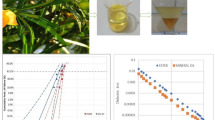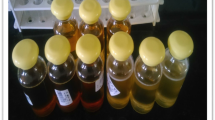Abstract
The quest for green alternative insulating oil in high-voltage equipment has been the desire of researchers for over decades. Vegetable oil has been considered as alternative insulating oil; this oil contains two different fatty acids, saturated and unsaturated. However, this fatty acid contains two opposing properties. In this work, physicochemical and dielectric properties of methyl ester from neem, yellow oleander and palm kernel oil were measured. The pour point of palm kernel oil methyl ester and the mixture of palm kernel oil methyl ester with yellow oleander methyl ester were obtained to be -9 °C and -2°, respectively. The viscosity of mineral oil is 9.5 mPas, that of palm kernel oil methyl ester, and mixture of palm kernel oil methyl ester and yellow oleander oil methyl ester were obtained to be 4.14 mPas and 4.38 mPas, respectively. A good dielectric loss relatively close to the dielectric loss of mineral oil was obtained for the mixture of palm kernel ester and yellow oleander ester. The mixture of the three methyl esters has the highest dielectric breakdown result of 26 kV better than the breakdown result of mineral oil. However, the optimization of all the parameters reveals that the mixture of palm kernel ester and yellow oleander ester has the desired property that can serve as an alternative for mineral insulating oil. Also, aging of the samples confirmed that mixture of palm kernel methyl ester and yellow oleander methyl ester has the potential to replace mineral oil.







Similar content being viewed by others
Data availability
Not applicable.
References
Bhatt MA, Bhatt PJ (2019) A review on electrical characteristics of nanofluid based transformer oil. Indian J Sci Technol 12(27):1–20. https://doi.org/10.17485/ijst/2019/v12i27/142960
Suhaimi SN, Rahman ARA, Din MF, Hassan MZ, Ishak MT, Bin Jusoh MT (2020) A review on oil-based nanofluid as next-generation insulation for transformer application. J Nanomater 2020:1–17. https://doi.org/10.1155/2020/2061343
Heathcote MJ (2007) J & P transformer book: a practical technology of the power transformer. Newnes
Suwarno, Sitinjak F, Suhariadi I, Imsak L (n.d.) Study on the characteristics of palm oil and it’s derivatives as liquid insulating materials. Proceedings of the 7th International Conference on Properties and Applications of Dielectric Materials (Cat.No.03CH37417). https://doi.org/10.1109/icpadm.2003.1218461
Fofana I (2013) 50 years in the development of insulating liquids. IEEE Electr Insul Mag 29(5):13–25. https://doi.org/10.1109/MEI.2013.6585853
Mohan Rao U, Fofana I, Jaya T, Rodriguez-Celis EM, Jalbert J, Picher P (2019) Alternative dielectric fluids for transformer insulation system: progress, challenges, and future prospects. IEEE Access 7:184552–184571. https://doi.org/10.1109/ACCESS.2019.2960020
Oparanti SO, Khaleed AA, Abdelmalik AA (2021) AC breakdown analysis of synthesized nanofluids for oil-filled transformer insulation. Int J Adv Manuf Technol. https://doi.org/10.1007/s00170-021-07631-0
Oparanti SO, Tambuwal FR, Khaleed AA, Abdelmalik AA (2021) DC and AC Breakdown Analysis of Neem Ester/ SiO2 Nanofluid for High Voltage Insulation. In: 2021 IEEE Conference on Electrical Insulation and Dielectric Phenomena (CEIDP), pp. 383-386.https://doi.org/10.1109/CEIDP50766.2021.9705313
Oparanti SO, Khaleed AA, Abdelmalik AA (2021) Nanofluid from palm kernel oil for high voltage insulation. Mater Chem Phys 259:123961. https://doi.org/10.1016/j.matchemphys.2020.123961
Sanjay B (2015) Yellow oleander (Thevetia peruviana) seed oil biodiesel as an alternative and renewable fuel for diesel engines: a review. Int J ChemTech Res 7(6):2823–2840
Tambuwal FR, Oparanti SO, Abdulkadir I, Sadiq U, Abdelmalik AA (2022) Investigative study on the AC and DC breakdown voltage of nanofluid from Jatropha-Neem oil mixture for use in oil-filled power equipment. Int J Adv Manuf Technol 119(7–8):4375–4383. https://doi.org/10.1007/s00170-021-08447-8
Abeysundara DC, Weerakoon C, Lucas JR, Gunatunga KAI, Obadage KC (2001) Coconut oil as an alternative to transformer oil. ERU Symposium 1:1–11
Abdelmalik AA (2014) Chemically modified palm kernel oil ester: A possible sustainable alternative insulating fluid. Sustain Mater Technol 1–2:42–51. https://doi.org/10.1016/j.susmat.2014.06.001
Amanullah M, Islam SM, Chami S, Ienco G (2005) Analyses of electro-chemical characteristics of vegetable oils as an alternative source to mineral oil-based dielectric fluid. IEEE Int Conf Dielectric Liquids 2005 2005:365–368. https://doi.org/10.1109/ICDL.2005.1490101
Soares S, Rocha FR (2020) Green volumetric procedure for determining biodiesel content in diesel blends or mixture with vegetable oils exploiting solubility differences in an ethanol: water medium. Fuel 276:118042. https://doi.org/10.1016/j.fuel.2020.118042
Basumatary B, Nath B, Kalita P, Das B, Basumatary S (2020) Yellow Oleander (Thevetia peruviana) Seed as a Potential Bioresource for Industrial Applications. Mini-Rev Org Chem 17(7):855–871. https://doi.org/10.2174/1570193x17666191230122142
Abdelmalik AA (2012) The Feasibility of Using a Vegetable Oil-Based Fluid as Electrical Insulating Oil, Doctoral dissertation. University of Leicester, Leicester
Oparanti SO, Abdelmalik AA, Khaleed AA, Abifarin JK, Suleiman MU, Oteikwu VE (2022) Synthesis and characterization of cooling biodegradable nanofluids from non-edible oil for high voltage application. Mater Chem Phys 277:125485. https://doi.org/10.1016/j.matchemphys.2021.125485
Burton R (2008) An overview of ASTM D6751: biodiesel standards and testing methods. Alternative fuels consortium
Sani L, Ajibola VO, Abechi SE (2018) Production and characterization of biodiesel-diesel blends from Terminalia catappa seed oil. Fudma J Sci 2(4):214–220
El-Sayed MM et al (2009) Prediction of the characteristics of transformer oil under different operation conditions. World Acad Sci Eng Tech 29:758–762
Kiema DW (2017) Study of steady and unsteady viscous incompressible mhd fluid flow, Doctoral dissertation. University of Eldoret, Eldoret
Sani L, Ajibola VO, Abechi SE (2019) Effect of degumming and catalyst type on physiochemical and biodiesel properties of tropical-almond (Terminalia catappa) seed oil. J Appl Sci Environ Manag 22(12):1909. https://doi.org/10.4314/jasem.v22i12.7
Abdulsalam IG et al (2022) Physico-chemical characterization of a multiparticle vegetable oil-based nanofluid for high voltage application. ATBU J Sci Technol Educ 9(4):298–303 (Available at: http://www.atbuftejoste.com/index.php/joste/article/view/1488. Accessed 25 Aug 2022)
ASTM D150–18 (2018) Standard test methods for AC loss characteristics and permittivity (dielectric constant) of solid electrical insulation. ASTM International, West Conshohocken
Umar S, Abdelmalik AA, Sadiq U (2018) Synthesis and characterization of potential bio based dielectric fluid from neem oil seed. Ind Crop Prod 115:117–123. https://doi.org/10.1016/j.indcrop.2018.02.009
Oparanti SO, Khaleed AA, Abdelmalik AA, Chalashkanov NM (2020) Dielectric characterization of palm kernel oil ester-based insulating nanofluid. IEEE Conf Electr Insul Dielectr Phenom (CEIDP) 2020:211–214. https://doi.org/10.1109/CEIDP49254.2020.9437477
Mohamad MS, Zainuddin H, Ab Ghani S, Chairul IS (2017) AC breakdown voltage and viscosity of palm fatty acid ester (PFAE) oil-based nanofluids. J Electr Eng Technol 12(6):2333–2341
Joshi AY, Joshi AY (2019) A systematic review on powder mixed electrical discharge machining. Heliyon 5(12):e02963. https://doi.org/10.1016/j.heliyon.2019.e02963
Azis N, Jasni J, Kadir MZAA, Mohtar MN (2014) Suitability of palm based oil as dielectric insulating fluid in transformers. J Electr Eng Technol 9(2):662–669. https://doi.org/10.5370/jeet.2014.9.2.662
Azeez OS, Olatunde ON, Adewolu O, Olutoye MA (2015) Refining and Characterization of Palm Kernel Oil Using Treated Charcoal and Clay. In: 1st International Engineering Conference, School of Engineering and Engineering Technology. Federal University of Technology, Minna
Abdulkareem B, Dan-asabe B, Abdullahi A (2019) Development of cutting fluid and optimization of its cutting speed from thevetia peruviana seeds oil. Jurnal Mekanikal 42(2)
SathyaSelvabala V, Varathachary TK, Selvaraj DK, Ponnusamy V, Subramanian S (2010) Removal of free fatty acid in Azadirachta indica (Neem) seed oil using phosphoric acid modified mordenite for biodiesel production. Biores Technol 101(15):5897–5902. https://doi.org/10.1016/j.biortech.2010.02.092
Tokunaga J, Nikaido M, Koide H, Hikosaka T (2019) Palm fatty acid ester as biodegradable dielectric fluid in transformers: a review. IEEE Electr Insul Mag 35(2):34–46. https://doi.org/10.1109/MEI.2019.8636104
Jin H, Andritsch T, Morshuis PHF, Smit JJ (2012) AC breakdown voltage and viscosity of mineral oil based SiO2 nanofluids. In: 2012 Annual Report Conference on Electrical Insulation and Dielectric Phenomena, pp 902-905. https://doi.org/10.1109/CEIDP.2012.6378927
Morsalin S, Phung BT (2017) A comparative study of dielectric dissipation factor measurement under very low and power frequencies. In: 2017 3rd International Conference on Condition Assessment Techniques in Electrical Systems (CATCON), pp 10–14. https://doi.org/10.1109/CATCON.2017.8280175
Raju GG (2016) Dielectrics in electric fields. CRC Press, UK
Shah ZH, Tahir QA (2011) dielectric properties of vegetable oils. J Sci Res 3(3):481–492. https://doi.org/10.3329/jsr.v3i3.7049
Makmud MZH, Illias HA, Chee CY, Sarjadi MS (2018) Influence of conductive and semi-conductive nanoparticles on the dielectric response of natural ester-based nanofluid Insulation. Energies 11(2):333. https://doi.org/10.3390/en11020333
Jadidian J, Zahn M, Lavesson N, Widlund O, Borg K (2012) Effects of impulse voltage polarity, peak amplitude, and rise time on streamers initiated from a needle electrode in transformer oil. IEEE Trans Plasma Sci 40(3):909–918. https://doi.org/10.1109/TPS.2011.2181961
Xu Y, Qian S, Liu Q, Wang ZD (2014) Oxidation stability assessment of a vegetable transformer oil under thermal aging. IEEE Trans Dielectr Electr Insul 21(2):683–692. https://doi.org/10.1109/TDEI.2013.004073
Ravindra A, Wolfgang M (2020) High voltage and electrical insulation engineering. John Wiley & Sons, Hoboken
Thakur S, Sarathi R, Danikas MG (2019) Investigation on thermal ageing impact on dielectric properties of natural ester oil. Electr Eng 101(3):1007–1018. https://doi.org/10.1007/s00202-019-00843-4
Funding
This work was supported by Nigeria’s Tertiary Education Trust Fund (TETFund) National Research Fund (NRF) Research Grant 2019. TETF/DR&D/CE/NRF/UNI/ZARIA/STI/55/VOL.1
Author information
Authors and Affiliations
Contributions
S.O. Oparanti contributed to conceptualization, investigation, formal analysis, writing—original draft, and writing—review and editing. Andrew Adewunmi Adekunle performed investigation, formal analysis, and writing—original draft. Victoria Ene Oteikwu performed formal analysis and writing—original draft. Abdulsalam Ismaila Galadima was involved in supervision, project administration, and writing—review and editing. Abdelghaffar Amoka Abdelmalik contributed to funding acquisition, supervision, project administration, and writing—review and editing.
Corresponding author
Ethics declarations
Ethics approval
Not applicable.
Competing interests
Not applicable.
Additional information
Publisher's note
Springer Nature remains neutral with regard to jurisdictional claims in published maps and institutional affiliations.
Rights and permissions
Springer Nature or its licensor holds exclusive rights to this article under a publishing agreement with the author(s) or other rightsholder(s); author self-archiving of the accepted manuscript version of this article is solely governed by the terms of such publishing agreement and applicable law.
About this article
Cite this article
Oparanti, S.O., Adekunle, A.A., Oteikwu, V.E. et al. An experimental investigation on composite methyl ester as a solution to environmental threat caused by mineral oil in transformer insulation. Biomass Conv. Bioref. (2022). https://doi.org/10.1007/s13399-022-03286-3
Received:
Revised:
Accepted:
Published:
DOI: https://doi.org/10.1007/s13399-022-03286-3




